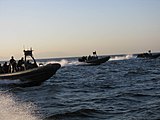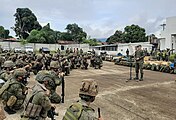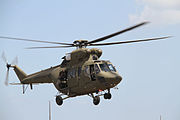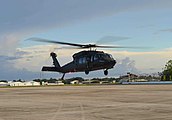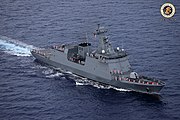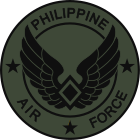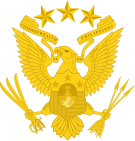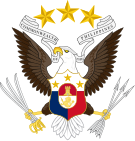Armed Forces of the Philippines

TheArmed Forces of the Philippines(AFP) (Filipino:Sandatahang Lakas ng Pilipinas) are the military forces of thePhilippines.It consists of three main service branches; theArmy,theAir Force,and theNavy(including theMarine Corps). ThePresident of the Philippinesis theCommander-in-Chiefof the AFP and forms military policy with theDepartment of National Defense,an executive department acting as the principal organ by which military policy is carried out, while theChief of Staff of the Armed Forces of the Philippinesserves as the overall commander and the highest-ranking officer in the AFP.
Founded under theNational Defense Act of 1935,while tracing its roots to thePhilippine Revolutionary Army,the AFP has played an integral part in the country's history. The AFP has also been involved in various conflicts, such as combattingrebellionagainst theCommunist Party of the Philippines(CPP) and its attached organizations, theNew People's Army(NPA) and theNational Democratic Front of the Philippines(NDF), and operations againstlocal Islamic terroristsinMindanao.The AFP has also been part of various peacekeeping operations around the world, as part of its contribution to theUnited Nations.[6]At present, military service is entirely voluntary.[7]
As a result of the diminished number of active communist rebels and jihadist groups in the 2020s, the AFP has been shifting its primary focus from handling internal threats such as insurgency and local terrorism to defending the Philippine territory from external threats.[8]
Leadership
[edit]- Commander-in-Chief:PresidentBongbong Marcos
- Secretary of National Defense(SND): SecretaryGilberto C. Teodoro Jr.,PAF(Res.)
- National Security Adviser:SecretaryEduardo M. Año
- Presidential Adviser for Military Affairs: Secretary Roman A. Felix
- Presidential Adviser on the West Philippine Sea:SecretaryAndres C. Centino
- Presidential Adviser for Peace, Reconciliation and Unity: Sec.Carlito G. Galvez Jr.
History
[edit]Pre-colonial Philippines maintained local militia groups under thebarangaysystem. Reporting to thedatu,these groups, aside from maintaining order in their communities, also served as their defense forces. With the arrival of Islam, the system of defense forces in the Mindanao region's sultanates under Muslim control mirrored those other existing sultanates in the region. These local warriors who were in the service of the Sultan were also responsible to qualified male citizens appointed by him.
During the Spanish colonial period, the Spanish Army was responsible for the defense and general order of the archipelago in the land, while the Spanish Navy conducts maritime policing in the seas as well as providing naval logistics to the Army. The Guardia Civil took police duties and maintaining public order in villages and towns. In the early years of Spanish colonial era, most of the formations of the army were composed of conquistadors backed with native auxiliaries. By the 18th and 19th centuries, line infantry and cavalry formations were created composed of mixed Spanish and Filipino personnel, as well as volunteer battalions composed of all-Filipino volunteers during the later half of the 19th Century. Units from other colonies were also levied to augment the existing formations in the Philippines. Almost all of the formations of the Spanish Army in the archipelago participated in the local religious uprisings between 17th and 19th centuries, and in thePhilippine Revolutionin 1896 fighting against the revolutionary forces. At the peak of the revolution, some Filipinos and a few Spaniards in the Spanish Army, Guardia Civil, and Navy defected to thePhilippine Revolutionary Army.
The Spanishcessionof the Philippines in the1898 Treaty of Parisput the independence of the newly declared Southeast Asian republic in grave danger. The revolutionaries were fighting desperately as the American forces already landed in other islands and had taken over towns and villages. The Americans established thePhilippine Constabularyin 1901 manned by Filipino fighters and used against Gen. Aguinaldo who was later captured.
On April 9, 2002, Philippine PresidentGloria Macapagal Arroyoproclaimed that the Philippine–American War had ended on April 16, 1902, with the surrender of GeneralMiguel Malvar.[13]
Since the beginning of American rule in the Philippines, the United States Army had taken the responsibility for the defense of the country in the land, and the United States Navy in the seas until the passage of the National Defense Act of 1935 which called for a separate defense force for the Philippines.
Creation and the Commonwealth Era
[edit]In accordance with theNational Defense Act of 1935,theArmed Forces of the Philippineswas officially established on December 21, 1935, when the act entered into force.[14]Retired U.S. GeneralDouglas MacArthurwas asked to supervise its foundation and training. MacArthur accepted the offer and became a Field Marshal of the Philippines, a rank no other person has since held.[15]Jean MacArthur,his wife, found the situation amusing and remarked that her husband had gone from holding the highest rank in the United States Army to holding the highest rank in a non-existent army.President Quezonofficially conferred the title of Field Marshal on MacArthur in a ceremony atMalacañan Palaceon August 24, 1936, when he appeared with a goldmarshal's batonand a unique uniform.[16]
The Army of the Philippines included naval and air assets directly reporting to Army headquarters, and the Philippine Constabulary, later part of the ground forces proper as a division. In 1938 the Constabulary Division was separated from the army and reorganized into a national police force.[17][18]
The administration of the military throughout the islands was divided into ten "military districts."[19]
| Military District | Areas Covered |
|---|---|
| 1st | North Luzon |
| 2nd | Lingayen and the Central Plain |
| 3rd | East Central Luzon, Bataan, and Zambales |
| 4th | South Central Luzon, including Manila, Batangas, Palawan, and Mindoro |
| 5th | East and Southeast Luzon and Catanduanes |
| 6th | Tablas, Panay, and Marinduque |
| 7th | Negros |
| 8th | Bohol and Cebu |
| 9th | Samar and Leyte |
| 10th | Mindanao and Sulu |
MacArthur expanded the Army of the Philippines with the revival of the Navy in 1940 and the formation of thePhilippine Army Air Corps(formerly the Philippine Constabulary Air Corps), but they were not ready for combat at the start of thePacific Warin December 1941 and unable to defeat the 1941–42 Japanese invasion of thePhilippines.
World War II
[edit]In 1940–41, most soldiers of the Philippine military were incorporated in theU.S. Army Forces Far East(USAFFE), with MacArthur appointed as its commander. USAFFE made its last stand onCorregidorIsland, after which Japanese forces were able to force all remaining Filipino and American troops to surrender. The establishment of the general headquarters of thePhilippine Commonwealth Armyare military station went to the province during the occupation. Those who survived the invasion but escaped from the Japanese formed the basis of recognized guerrilla units and ongoing local military force of thePhilippine Commonwealth Armythat continued the fighting against the enemy all over the islands. ThePhilippine Constabularywent on active service under the Armed Forces of the Philippines during liberation.
After independence
[edit]AfterJapanwas defeated in World War II, the Philippines gained its independence in 1946. (This was its second independence after thePhilippine Declaration of Independencein 1898).
The pre-war military districts briefly continued to be used for administering the military,[19]until they were reorganized into Military Area Commands in 1946.[20]In 1947 the modern AFP first emerged with the upgrade of the PAAC to thePhilippine Air Force.
1950 saw the creation of thePhilippine Marine Corps,a naval infantry force under the command of the Philippine Navy, after then-Defense SecretaryRamon Magsaysayordered CommodoreRamon Alcarazto go to study the organization of the U.S. Marines. Alcaraz recommended the creation of the new service, earning him the distinction of being the "Father" of thePhilippine Marine Corps.[21]
During theKorean Warfrom 1951 to 1953, the Philippines sent various AFP battalions, known as thePhilippine Expeditionary Forces to Korea(PEFTOK) to fight as part of the US-ledUnited Nations Commandin liberatingSouth Koreafrom the invading North Korean troops.
Throughout this time, the AFP had been in conflict with various elements of theHukbalahapwhich, still known as the "huks", were reconstituted as theHukbong Mapagpalaya ng Bayan( "Peoples' Liberation Army" )the armed wing of the Marxist–LeninistPartido Komunista ng Pilipinasof 1930 (PKP-1930). This conflict effectively ended in 1954, with the huks becoming a spent force during the presidency ofRamon Magsaysay.[22]: 44
In 1966, an AFP battalion was also sent intoSouth Vietnamduring theVietnam Warto ameliorate the economic and social conditions of its people there. AFP units were also sent at the same time to theSpratly Islands.
1963 would see the first women join the ranks of the armed forces with the raising of the Women's Auxiliary Corps.
Martial law
[edit]PresidentFerdinand Marcossought to have a strong personal influence over the Armed Forces as soon as he became president in 1965,[23][24]: "32" holding on to the portfolio of defense secretary in the first thirteen months of his presidency[25]to develop what scholars have noted to be "a patronage system within the defense establishment."[26]The portfolio afforded him direct interaction with the AFP's leadership, and to have a hand in the AFP's day-to-day operationalization.[27]
Upon the declaration ofmartial lawin 1972, Marcos used the AFP as what theDavide Commission Reportwould later call his "martial law implementor,"[28]and "one of the vital supports of the regime."[28]Upon the announcement of Martial Law in 1972, one of their earliest tasks was that of quickly arresting and containing Marcos' political opponents,[29]and Marcos' hold on power was effectively broken once enough of the Military withdrew their support from him in February 1986.[30]Antonio Parlade notes that to get the military to ensure their cooperation, Marcos "had to expand the military organization and patronize the generals to buy their loyalty."[23][31]
Marcos oversaw a significant expansion of the AFP, which grew from a force of 57,100 in 1971 to a 97.89 percent increase of 113,000 personnel in 1976 - a significant increase of over a five-year period.[28]He also increased the military budget from P880 million in 1972 to P4 billion in 1976.[28]Marcos also instituted the AFP Self Reliance Defense Posture (SRDP) program, which was supposed to enable the AFP to construct its own weapons, tanks, armored vehicles, ships, gunboats, and aircraft locally instead of buying from foreign sources.[32]This included[citation needed]"Project Santa Barbara"under the Philippine Navy, which saw the testing of theBongbong IIMLRS- named after Marcos' son - in 1972. However, the project was discontinued before the Marcos administration ended.[33][undue weight?–discuss][better source needed]
The military was given many functions aside from its task of national defense, including assisting in the implementation of price controls imposed on key products like corn and rice, enforcing the rules of the national corn procurement program, assisting in the collection of rural and government bank loans, implementing the agrarian reform law, and various police functions such as collecting unlicensed firearms and enforcing curfews, and suppressing strikes, rallies, and other demonstrations.[28]
Marcos carried out the "largest reshuffle in the history of the armed forces" when he forcibly retired fourteen of the AFP's twenty-five flag officers, including the AFP Chief of Staff, the AFP Vice Chief of Staff, the commanding general of the Philippine Army, the Chief of the Philippine Constabulary, the commanders of all four Constabulary Zones, and one third of all Provincial Commanders of the PC.[34]Other key officers critical of Marcos, such as CommodoreRamon Alcaraz,were compelled to leave the service.[21]In their place, Marcos appointed officers from his home region, the Ilocos, the most significant of whom had familial connections to Marcos – ensuring their familial and regionalistic loyalties to him.[27][26]
Among the most prominent such appointments were that of GeneralFabian Veras commander of the Presidential Security Command in 1965, and AFP chief of staff in 1981;[35][36]Juan Ponce Enrileas Secretary of Defense from 1970 to 1986;[35]and GeneralFidel Ramosas chief for the Philippine Constabulary, and later as Armed Forces Vice Chief from 1981 to 1986.[35]
Generals loyal to Marcos were allowed to stay in their positions past their supposed retirement age, or were rewarded with civilian government posts.[37]This led to a loss of morale among the middle-ranks of the AFP, because it meant a significant slowdown in promotions and caused many officers to retire with ranks much lower than they would otherwise have earned.[27][34]
Several cabals of dissatisfied officers eventually formed among the middle-ranks of the AFP, most notably theReform the Armed Forces Movementin the early 1980s.[34]
The Marcos administration is thus considered to have marked a decline for AFP in terms of its traditional values of civilian supremacy and professionalism,[38][39]leading to a need for security sector reform during later administrations,[39]as per the recommendations of theDavide Commissionin 1990 and the Feliciano Commission in 2003.[40][41]
Civilian[42][43]and military[23]historians alike agree that "human rights abusesby the troops became rampant "[23][31]during the Marcos administration,[23]as documented by international monitoring entities such asAmnesty International.[44]Units often specifically cited in these reported incidents include theMetrocom Intelligence and Security Group (MISG),[45]and the 5th Constabulary Security Unit (5CSU)[46]of thePhilippine Constabulary,[47]as well as the Intelligence Service Armed Forces of the Philippines (ISAFP).[48]The Presidential Security Unit and theNational Intelligence and Security Agency(NISA) were also accused of aiding these activities.[49]Aside from human rights abuses, these units were also accused of hounding media entities,[50][51]corporate management,[52]and opposition groups[53]with threats, intimidation, and violence.
The Marcos administration also marked the beginnings of at least two long-running conflicts that continued to plague later administrations: the Moro conflict and theNew People's Armyconflict.[54]
TheMoro conflict,began in earnest in 1968 when short-lived organizations such as theMuslim Independence Movementand theBangsamoro Liberation Organizationformed in reaction to news about theJabidah Massacre,[55][56][57]with many of their forces eventually coalescing as theMoro National Liberation Frontwas formed in 1972.[54][55]
Meanwhile, theCommunist Party of the Philippines(CPP) was formed in 1968, while theNew People's Army(NPA), founded in 1969,[54]grew nationwide to a 200,000 strong force.[citation needed]
EDSA Revolution
[edit]Due to what was popularly believed to be electoral fraud during the1986 Philippine presidential election,[58]February 1986 saw a period of uncertainty.[59][60]A boycott movement and plans for massive civilian protests were in place.[61]
During the chaos, theReform the Armed Forces Movementheaded by then Defense MinisterJuan Ponce Enriledecided to stage a military coup against Marcos.[62]The plot was uncovered,[63]however, and the forces involved became trapped inCamp AguinaldoinQuezon City.They then sought and received the support ofPhilippine Constabularychief and AFP vice-chief of staff Lt. GeneralFidel V. Ramosin the neighboringCamp Crame,but even with Ramos' defection, their forces were trapped in the two neighboring camps.
Manila's Catholic Archbishop,Jaime Sin,went onRadio Veritasand called for people to go to the section ofEpifanio de los Santos Avenuein between the two camps and help protect the rebel forces.[62]Since civilian groups were already planning massive protests in relation to the election results, a large crowd was able to gather and prevent Marcos' forces from attacking camps Aguinaldo and Crame.[60][61]This civilian uprising, which would come to be known as thePeople Power Revolution,led to various units of the AFP refusing orders to fire on the camps and the civilians protecting them, and led to the removal Marcos from power.[64][65]Corazon Aquinowas then installed as the new president of the Philippines.[66]
Shortly after midnight on February 26, five army trucks of troops under the command of Fidel Ramos arrived in Malacañang Palace to secure it after Ferdinand Marcos had left, and various individuals had entered it, marking the end of Marcos' reign, and placing the palace under the control of theProvisional Government of the Philippinesuntil a new constitution could be enacted a year later, in 1987.[67]
Later 20th century
[edit]DuringCorazon Aquino's administration,most of the military units remained loyal to her as she dealt with various coup attempts against her, either by military factions that remained loyal to the former dictator,[28]: 135 or by theReform the Armed Forces Movement.[28]The1989 coup attempt,the bloodiest of all coup attempts against her, was crushed with US help.[citation needed]
Following the 1989 coup attempt, President Aquino established a Fact-Finding Commission headed by COMELEC ChairmanHilario Davide Jr.to investigate and provide a full report on the series of coup attempts.[68][69]When it came out, TheDavide Commission Reportrecommended several short-term and long-term counter-measures, including the establishment of a civilian national police force, a crackdown on corruption in the military, a performance review of appointive government officials, reforms in the process of military promotions, a review of election laws in time for the 1992 presidential elections, and a definitive statement on the part of Aquino on whether she intended to run for re-election in 1992.[28]: 509–530 [70]The publication of the recommendations of the report is considered one of the key starting points of security sector reform in the Philippines.[39][40]
The AFP, during her term also launched a massive campaign against the CPP-NPA after a brief hiatus and also against theMoro National Liberation Front(MNLF) in the south.[citation needed]
In 1991, the major services of the AFP were reduced from four to three, when thePhilippine Constabularyor PC, an AFP major service tasked to enforce the law and to curb criminality, was formally merged with the country'sIntegrated National Police,a national police force on the cities and municipalities in the country attached to the PC to become thePhilippine National Police,thus removing it from AFP control and it was civilianized by a law passed by Congress, therefore becoming under theDepartment of the Interior and Local Governmentas a result.[71]
Contemporary history
[edit]This section needs to beupdated.(June 2023) |
In 2000, on PresidentJoseph Estrada's orders, the AFP launched anall-out offensiveagainst theMoro Islamic Liberation Front,a breakaway group of the MNLF that wants to proclaim Mindanao an independent state.[72]The AFPsucceeded in capturingthe MILF's main headquarters,Camp Abubakaron July 9.[73]
The AFP played a key role in the two-dayEdsa DosPeople Power revolt in 2001; the revolution removed Estrada from power and installed then vice-presidentGloria Macapagal Arroyoas president.[74]
Since 2001, the Armed Forces of the Philippines has been active in supporting theWar on terrorand has been attacking terrorist groups in Mindanao ever since. In 2012, the AFP Chief of Staff said that there had been no increase in the number of soldiers over a long period, and that the military aimed to hire 30,000 troops in three years.[75]
In 2013, the AFP successfullyquelled the Zamboanga City attacksof theMoro National Liberation Front,which proclaimed the independence of the short-livedBangsamoro Republik.[76]
After the signing of theComprehensive Agreement on the Bangsamoroin 2014, the AFP has played a key part in the normalization process with the MILF, which includes "the decommissioning of MILF combatants and their weapons and the transformation of several camps into productive and resilient communities,"[77]developing a close working relationship with the Philippine National Police and the MILF-Bangsamoro Islamic Armed Forces (BIAF) in thepursuit of peacein theBangsamoro.[78]
In 2016, the AFP clashed with theMaute grouponButigonFebruary,late May to early June,[79]and onNovemberof 2016.
Under PresidentRodrigo Dutertein May 2017, the AFP thwarted theISIS militants'attempt to establish a foothold in the Philippines in thefive-month-long siegeto retakeMarawifrom militant occupation.[80]The AFP called President Duterte to declareMartial LawunderProclamation No. 216.[citation needed]Additionally, the AFP and theNTF-ELCACwere at the forefront of Duterte's intensified campaign against the communist rebellion; by the of Duterte's term, the AFP reported the reduction of NPAguerrilla frontsfrom 89 to 23, and only 2,000 remained of more than 25,000 "members, supporters, and sympathizers of the underground movement".[81]
In 2024, the number of active communist rebels in the NPA reached a low of 1,500, with the AFP aiming to neutralize them by the end of the year. As a result of the development, the AFP under theBongbong Marcos administrationhas been shifting its focus away from handling internal threats towards defending Philippine territory from external threats such as China'sencroachmentin theWest Philippine Sea.[82]
Organization and branches
[edit]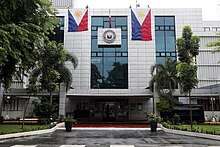
The1987 Philippine Constitutionplaced the AFP under the control of a civilian, thePresident of the Philippines,who acts as itsCommander-in-Chief.All of its branches are part of theDepartment of National Defense,which is headed by theSecretary of National Defense.
The AFP has three major services:[83]
- Philippine Army(PA) –Hukbong Katihan ng Pilipinas
- Philippine Navy(PN) –Hukbong Dagat ng Pilipinas
- Philippine Marine Corps(PMC) –Hukbong Kawal Pandagat ng Pilipinas
- Philippine Air Force(PAF) –Hukbong Himpapawid ng Pilipinas
These three major services are unified under theChief of Staff of the Armed Forces of the Philippines(CSAFP) who normally holds the rank ofGeneral/Admiral.The AFP Chief of Staff is primarily assisted by:
- The Vice Chief of Staff of the AFP (VCSAFP)
- The Deputy Chief of Staff of the AFP (TDCSAFP)
Both normally holding the rank ofLieutenant General/Vice Admiral.
The three highest posts of the AFP are also assisted by the Secretary Joint Staff (SJSAFP), who serves as the primary executive officer for the AFP Chief of Staff, the Vice Chief of Staff, and The Deputy Chief of Staff.
Each of the three major branches are headed by an officer with the following titles:
- Commanding General of the Philippine Army(CGPA) -Lieutenant General
- Flag Officer in-Command(FOIC) -Vice Admiral
- Commanding General of the Philippine Air Force(CGPAF) -Lieutenant General
- Commander, Unified Commands (Lieutenant General/Vice Admiral)
Meanwhile, the Chief of Staff of the AFP is also assisted by the 10 following office holders carry the rank ofMajor General/Rear Admiral,who serves as the members of the Joint Staff Divisions, at the General Headquarters inCamp Aguinaldo.These Joint Staff Divisions are also part of the Joint Staff, which is composed of the AFP Chief of Staff, the Vice Chief of Staff and The Deputy Chief of Staff.
- The Deputy Chief of Staff for Personnel, J1
- The Deputy Chief of Staff for Intelligence, J2
- The Deputy Chief of Staff for Operations, Organization & Training, J3
- The Deputy Chief of Staff for Logistics, J4
- The Deputy Chief of Staff for Plans, J5
- The Deputy Chief of Staff for Communications, Electronics and Information Systems, J6
- The Deputy Chief of Staff for Civil-Military Operations, J7
- The Deputy Chief of Staff for Education, Training and Doctrine, J8
- The Deputy Chief of Staff for Retirees and Reservists Affairs, J9
- The Deputy Chief of Staff for Financial Management, J10
The AFP also comprises the Special Staff, which is divided into two separate groups. These groups also assist the AFP Chief on their designated fields:[84]
- The Administrative Staff:
- The Inspector General (TIG) -Lieutenant General/Vice Admiral
- The Adjutant General (TAG)
- The Judge Advocate General (TJAG)
- The Chief, Chaplain Service (TCCS)
- The Provost Marshal General (TPMG)
- The Chief, Special Services (TCSPS)
- The Chief, Historical Activities (TCHA)
- The Chief, Doctrines Development (TCDD)
- The Technical Staff:
- The Chief Engineer
- The Chief for Ordinance and Chemical Service
- The Quartermaster General
- The Surgeon General
- The Chief Nurse
The AFP Chief is also assisted by the following office commanding division-sized troops holders carry the rank ofMajor General/Rear Admiral:
- Army Division Commanders
- Naval Command Commanders
- Air Command Commanders
- The Commandant of thePhilippine Marine Corps
On June 19, 2020, under the DND Order no. 174, the AFP had major changes in renaming its positions in high-ranking officials, such as the following:[85]
- Chief of Staff of the AFP - Chairman of the Joint Chiefs
- Vice Chief of Staff of the AFP - Vice Chairman of the Joint Chiefs
- The Deputy Chief of Staff of the AFP - Chief of the Joint Staff
- Commander, Unified Command - Joint Forces Commander, Unified Command
- Deputy Chief of Staff for (functional area) (J-staff) - Deputy Chief of the Joint Staff for (functional area)
- Commanding General of the Philippine Army- Chief of the Army
- Flag Officer in-Command- Chief of the Navy
- Commanding General of the Philippine Air Force- Chief of the Air Force
However, the AFP has deferred these title changes a few months later as PresidentRodrigo Duterterevoked the usage of the position titles, and decided to maintain the traditional position titles.[86]
Unified commands
[edit]Units from these three services may be assigned to one of six "Unified Commands" led by each Commander of the Unified Command; consisting of different branches from the three branches of the AFP, which are multi-service, regional entities. The Unified Commands are responsible in monitoring, securing and defending their specific geographical area of operations within the Philippines. There are currently six Unified Commands in the AFP, with each Commander of the Unified Commands hold the rank ofLieutenant General/Vice Admiral,and reports directly to the office of theChief of Staff of the Armed Forces of the Philippines.[87]
- Northern Luzon Command (NOLCOM)(Ilocos Region,Cordillera Administrative Region,Cagayan Valley,andCentral Luzon,including theScarborough Shoaland theBenham Rise)
- Southern Luzon Command (SOLCOM)(Calabarzon;MimaropaexcludingPalawan,andBicol Region)
- Visayas Command (VISCOM)(Western Visayas,Central Visayas,Eastern Visayas)
- Western Command (WESCOM)(Palawanand theSpratly Islands)
- Eastern Mindanao Command (EASTMINCOM)(Davao Region,Soccsksargen,and theCaragaregions)
- Western Mindanao Command (WESTMINCOM)(Zamboanga Peninsula,Northern Mindanao,and theBARMM)
Commanders, Unified Commands
[edit]| Commander, AFP Northern Luzon Command | Appointed | Branch | |
|---|---|---|---|
| Lieutenant GeneralFernyl G. Buca[88] | January 25, 2023 (1 year, 250 days) |
 Philippine Air Force | |
| Commander, AFP Southern Luzon Command | Appointed | Branch | |
| Lieutenant GeneralFacundo O. Palafox IV[89] | March 3, 2024 (212 days) |
 Philippine Army | |
| Commander, AFP Visayas Command | Appointed | Branch | |
| Lieutenant GeneralFernando M. Reyeg[90][91] | April 24, 2024 (160 days) |
 Philippine Army | |
| Commander, AFP Western Command | Appointed | Branch | |
| Vice AdmiralAlfonso F. Torres Jr.[92] | May 18, 2024 (136 days) |
 Philippine Navy | |
| Commander, AFP Eastern Mindanao Command | Appointed | Branch | |
| Lieutenant GeneralLuis Rex D. Bergante[93][94] | June 7, 2024 (116 days) |
 Philippine Army | |
| Commander, AFP Western Mindanao Command | Appointed | Branch | |
| Lieutenant GeneralWilliam N. Gonzales[95] | November 3, 2023 (333 days) |
 Philippine Army | |
AFP-wide service support and separate units
[edit]Several organization-wide support services and separate units report directly to the Armed Forces of the Philippines General Headquarters (AFP GHQ). The units are the:
- AFP General Headquarters & Headquarters Service Command (GHQ & HSC)
- AFP Joint Task Force-National Capital Region(AFP JTF-NCR)
- Presidential Security Group(PSG)
- Philippine Military Academy(PMA)
- AFP Education, Training and Doctrine Command (AFPETDC). The organizations under it include:
- AFP Health Service Command. The organizations under it include:
- Armed Forces of the Philippines Medical Center(AFPMC)
- Armed Forces of the Philippines Dental Service Center (AFPDSC)
- AFP Special Operations Command (AFPSOCOM)
- AFP Reserve Command (AFPRESCOM)
- AFP Commissary and Exchange Service (AFPCES)
- Civil Relations Service, AFP (CRSAFP)
- Communications, Electronics and Information System Service, AFP (CEISSAFP)
- Intelligence Service, AFP (ISAFP)
- Counterintelligence Group (CIG)
- AFP Doctrine Development Center (AFPDDC)
- AFP Peacekeeping Operations Center (AFP-PKOC)
- Citizen Armed Force Geographical Unit(CAFGU)
Former branches
[edit]ThePhilippine Constabulary(PC) was agendarmerietype military-police force of the Philippines established in 1901 by the United States-appointed administrative authority, replacing theGuardia Civilof the Spanish colonial regime. On December 13, 1990, Republic Act No. 6975 was approved, organizing thePhilippine National Police(PNP) consisting of the members of theIntegrated National Police(INP) and the officers and enlisted personnel of the PC. Upon the effectivity of that Act, the PC ceased to be a major service of the Armed Forces of the Philippines and the INP ceased to be the national police and civil defense force.[96]On January 29, 1991, the PC and the INP were formally retired and the PNP was activated in their place.[97]
ThePhilippine Coast Guard(PCG) is also another attached agency to the Armed Forces of the Philippines, but due to the civilian nature of the PCG functions led to the separation of the Coast Guard from the Philippine Navy on March 30, 1998, by virtue of Executive Order 475 signed by President Fidel Ramos. The Order effectively transferred the PCG from the Department of National Defense to the Office of the President, and eventually to the Department of Transportation and Communications (DOTC) on April 15, 1998, by virtue of Executive Order 477.
Defunct former commands
[edit]- National Capital Region Command (NCRCOM)
- Eastern Command
- Central Luzon Command (CELCOM)
- Central Mindanao Command (CENMINCOM)
- Southern Command (SOUTHCOM)
- Home Defense Command (HDC)
- Internal Defense Command (IDC)
- National Development Support Command (NADESCOM)
Reforms and modernization
[edit]The AFP is one of the "core security actors"[40]that are the focus ofsecurity sector governance and reform in the Philippines,which involves civilianizing, professionalizing, modernizing, and capacitating the Philippine government's security institutions[40][98][99]to align themgood governanceand to principles such ashuman rights,freedom of information,and therule of civilian law.[100][101]This has been a continuing process since the establishment of theFifth Philippine Republicafter the 1986People Power Revolution,[98]before the concept had even been fully defined internationally in the 1990s.[102]
Civilianization
[edit]The need to assertcivilian control of the militarywas a reform agenda which began being addressed almost as soon asFerdinand Marcoswas deposed by the 1986People Power Revolution;within a year of Marcos' ouster, the 1987 Constitution of the Philippines enshrined the principle of civilian supremacy over the military.[103]After the variouscoup attempts of the 1980s,the recommendations of theDavide Commissionincluded the dissolution of thePhilippine Constabularyas a service under the AFP, resulting in the eventual creation of the civilianPhilippine National Police.[104]In 1998, Executive Orders 475 and 477 asserting the civilian nature of thePhilippine Coast Guardand transferring it from thePhilippine Navyto the Department of Transportation and Communications (DOTC) were signed by President Fidel Ramos.[105]
In a December 2013 paper for theNational Defense College of the Philippines’ National Security Review, formerDepartment of National DefenseUndersecretary Rodel Cruz identified some aspects of civilianization which need attention under security sector reform as:[40]
- Increasing civilian capacity for defense management;
- Establishing an active constituency supportive of Security Sector Reform;
- Prudent budget preparation and execution;
- Supporting a local defense industry;
- Intelligent and coherent policy development and execution; and
- the passage of an updated National Defense Act.
Involvement of Civil Society
[edit]For the most part, oversight of the Philippine state's security actors has fallen on government agencies through the constitutional system of checks and balances - most prominently, congress and the Commission on Human Rights.[103]But civil society organizations have also become involved in civilianizing, professionalizing, modernizing, and capacitating the Philippine state's security institutions, depending on how much emphasis each President, as Commander in Chief, places on civil society engagement.[106]
Given a greater emphasis on Philippine Defense Reform (PDR) beginning in 2010, a shift towards engagement with Civil Society Organizations was put in place under the Internal Peace and Security Plan (IPSP) of 2010, and similar principles were enshrined in the 2016 AFP-Development Support and Security Plan (DSSP) of the next administration.[107]However, civil society is no longer identified as a major strategic priority under the 15 year AFP Transformation Roadmap initiated during the Duterte administration, as it had been under the 2003-2016 PDR Program.[108]
Professionalization
[edit]The AFP went through a number of changes during the 21 years under Ferdinand Marcos, notably in terms of the promotion of officers based on loyalty and connections to the president, and in terms of being given the task of implementing Martial Law, which led to officers being involved in human rights violations and in corruption.[40]The years from 1965 to 1986 are thus considered to have marked a decline for AFP in terms of its traditional values of civilian supremacy and professionalism,[38][39]leading to a need to actively professionalize the AFP.[39][40]The 1990 Davide Commission and 2003 Feliciano Commission made recommendations towards the professionalization of the AFP as early as 1990 and 2003, respectively.[38][40]
Under the Philippine Defense Reform (PDR) Program from 2003 to 2016, steps the AFP sought to take towards professionalization included the development of "Integrity Development Programs", programmatic efforts to improve the quality of service performance, continuing development programs for commanders and staff, and reforms in the recruitment of enlisted personnel.[109]Alongside capability development, "professionalization of all ranks" is one of two strategic priorities identified by the 15 year AFP Transformation Roadmap which replaced the PDR Program during the Duterte administration.[108]
Modernization
[edit]Republic Act No. 7898, approved by PresidentFidel V. Ramoson February 23, 1995, declared it the policy of the State to modernize the AFP to a level where it can effectively and fully perform its constitutional mandate to uphold the sovereignty and preserve the patrimony of the Republic of the Philippines, and mandated specific actions to be taken to achieve this end[110]over a 15-year period ending in 2010.[111]Republic Act No. 10349, approved by PresidentBenigno Aquino IIIon December 11, 2012, amended RA7898 to establish a revised AFP modernization program[112]lasting another 15 years ending in 2027.[111]The act included new provisions for the acquisition of equipment for all the branches of AFP.[citation needed]
Philippine Defense Reform Program (2003-2016)
[edit]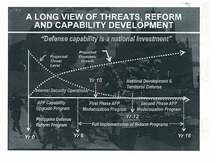
In October 1999, the Joint Defense Assessment (JDA) began as a policy level discussion between the Philippine Secretary of National Defense and the US Secretary of Defense. An initial JDA report in 2001 provided an objective evaluation of Philippine defense capability. During a May 2003 state visit to Washington DC, President Arroyo requested U.S. assistance in conducting a strategic assessment of the Philippine defense system. This led to a follow-up JDA and formulation of recommendations addressing deficiencies found in the Philippine defense structure.[113]
The results of the 2003 JDA were devastating. The JDA findings revealed that the AFP was only partially capable of performing its most critical missions. Moreover, the results pointed overwhelmingly toward institutional and strategic deficiencies as being the root cause of most of the shortcomings. A common thread in all: the lack of strategy-based planning that would focus DND/AFP on addressing priority threats and link capability requirements with the acquisition process.
Specifically, the 2003 JDA revealed critical deficiencies in the following specific areas:[114]
- Systemic approach to policy planning
- Personnel management and leadership
- Defense expenditures and budgeting
- Acquisition
- Supply and maintenance
- Quality assurance for existing industrial base
- Infrastructure support
During a reciprocal visit to the Philippines in October 2003 by U.S. President Bush, he and President Arroyo issued a joint statement expressing their commitment to embark upon a multi-year plan to implement the JDA recommendations. The Philippine Defense Reform (PDR) Program is the result of that agreement.
The JDA specifically identified 65 key areas and 207 ancillary areas of concern. These were reduced to ten broad-based and inter-related recommendations that later became the basis for what became known as the PDR Priority Programs. The ten are:[115]
- Multi-Year Defense Planning System (MYDPS)
- Improve Intelligence, Operations, and Training Capacities
- Improve Logistics Capacity
- Professional Development Program
- Improve Personnel Management System
- Multi-year Capabilities Upgrade Program (CUP)
- Optimization of Defense Budget and Improvement of Management Controls
- Centrally Managed Defense Acquisition System Manned by a Professional Workforce
- Development of Strategic Communication Capability
- Information Management Development Program
From the perspective of the Philippine Department of National Defense (DND), the framework for reforms is based on an environment of increasing economic prowess and a gradually decreasing threat level over time, and seeks to make the following improvements:[116] 1. Address AFP capability gaps to enable the AFP to effectively fulfill its mission. 2. Implement capability for seamless interoperability by developing proficiency in the conduct of joint operations, eliminating crisis handling by individual major services as done previously. 3. improve effectiveness of internal security operations. 4. Enhance capability to counter terrorism and other transnational threats. 5. Provide sustainment and/or long-term viability of acquired capabilities. 6. Improve cost-effectiveness of operations. 7. Improve accountability and transparency in the DND. 8. Increase professionalism in the AFP through reforms in areas such as promotions, assignments, and training. 9. Increase involvement of AFP in the peace process.

According to the goals stated in the Philippines Defense Reform Handbook: "The PDR serves as the overall framework to re-engineer our systems and re-tool our personnel."[117]The Philippine Defense Reform follows a three-step implementation plan:[118] 1. Creating the environment for reform (2004–2005); 2. Enabling the defense establishment (2005–2007); 3. Implementing and institutionalizing reform (2007–2010).
On September 23, 2003, President Arroyo issued Executive Order 240, streamlining procedures for defense contracts for the expeditious implementation of defense projects and the speedy response to security threats while promoting transparency, impartiality, and accountability in government transactions. Executive Order 240, creating the Office of the Undersecretary of Internal Control in the DND, mandated in part to institutionalize reforms in the procurement and fund disbursement systems in the AFP and the DND.[119]On November 30, 2005, the Secretary of National Defense issued Department Order No. 82 (DO 82), creating the PDR Board and formalizing the reform organizational set-up between the DND and the AFP and defining workflow and decision-making processes.[120]
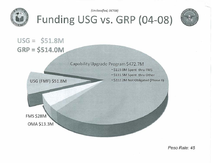
The PDR is jointly funded by the U.S. and R.P. governments. From 2004 to 2008, funding amounted to $51.8 million from the U.S. and $514.0 million from the RP.[121]Initial planning assumptioned that the 18-year span of reform would encompass a period of steady rise in economic growth coupled with equally steady decline in the military threat from terrorists and separatists. Neither of these projections have proven accurate. As of 2010[update],at the six-year mark of PDR, the Philippine economy was internally strong, but suffering during a period of recession that crippled Philippine purchasing power. Worse, the threat situation in the Philippines had not improved significantly, or as in the case of the Sulu Archipelago, was deteriorating.[122]
During the Arroyo presidency, deliberate 'Rolodexing' of senior leadership within the DND and AFP constantly put U.S. PDR advocates in a position of re-winning previously won points and positions, and gave U.S. observers a 'two steps forward, one step back' impression of the program. As of 2010[update],U.S. observers were uncertain whether Arroyo's successor,Benigno Aquino III,chosen in Philippine Presidential elections on May 10, 2010, will continue the tradition of rapid turnover of senior leadership.[123]
U.S. observers have reported that overall progress of the PDR is unmistakable and has clearly struck a wider swath of the Philippine defense establishment than originally hoped. However, they see some troubling signs that the depth of the PDR's impact may not be as significant as originally desired. For example, the Philippine legislature continues to significantly underfund the DND and AFP, currently at.9 percent of GDP, compared to an average of 2 percent worldwide, and a 4 percent outlay by the U.S. Even with full implementation of all the PDR's programs and recommendations, the defense establishment would not be able to sustain itself at current funding levels. While this can be made up by future outlays, as of 2010[update]observers see no outward sign the legislature is planning to do so.[123]One U.S. observer likened PDR process to the progress of aJeepneyon a busy Manila avenue—explaining, "a Jeepney moves at its own pace, stops unexpectedly, frequently changes passengers, moves inexplicably and abruptly right and left in traffic, but eventually arrives safely."[124]President Aquino has promised to implement the PDR program.[125]As of 9 March 2011[update],a major Philippine news organization tracking performance on his promises evaluated that one as "To Be Determined."[126]
TheMutual Defense Treatybetween the Philippines and the United States has not been updated since its signing in 1951. As of 2013[update],discussions were underway for a formal U.S.-Philippine Framework Agreement detail how U.S. forces would be able to "operate on Philippine military bases and in Philippine territorial waters to help build Philippine military capacity in maritime security and maritime domain awareness."[127]In particular, this Framework Agreement would which would increase rotational presence of American forces in the Philippines.[128]
Longstanding treaties, such as the aforementioned 1951 Mutual Defense Treaty and theUnited Nations Convention on the Law of the Sea(UNCLOS) of 1982,[129]are of great importance to the Philippines in supporting maritime security in particular; respectively, their legally binding nature provides long-term effectiveness for mutual defense cooperation and for the development of the Philippine maritime and archipelagic domain.
Philippine defense operations are supported in part through U.S. Section 1206 ($102.3 million) and 1207 ($16.02 million) funds. These funds are aimed at carrying out security, counterterrorism training and rule of law programs.[130]Overall, the United States is increasing U.S. funding for military education and training programs in Southeast Asia. The most recent U.S. Department of Defense budget for the region includes $90 million for programs, which is a 50 percent increased from four years ago.[131]
Defense SecretaryVoltaire T. Gazminformally ended the PDR Program on June 23, 2016, because the upcoming administration of Rodrigo Duterte, which would begin its term later that month, had indicated that it wanted to set its own direction for the running of Philippine defense matters.[132]
Fixed Term for key officials
[edit]On May 16, 2022, theMalacañang Palaceannounced that the PresidentRodrigo Dutertehas signed a law, known as Republic Act no. 11709, that enables a three-year fixed term for key officials of the Armed Forces of the Philippines, such asChief of Staff of the Armed Forces of the Philippines,the Vice Chief of Staff of the Armed Forces of the Philippines, the Deputy Chief of Staff of the Armed Forces of the Philippines, theCommanding General of the Philippine Army,theCommanding General of the Philippine Air Force,theFlag Officer-in-Command of the Philippine Navy,The Inspector General, and for the respective commanders of the Unified Commands. Meanwhile, junior officers ranging from the ranks of second lieutenant/ensign to colonel/captain, as well as enlisted personnel, will be compulsorily retired upon reaching the age of 56 or served a maximum of 30 years of active service, while flag officers who reached the rank of brigadier general/commodore to lieutenant general/vice admiral will have a retirement age of 59, unless named as a commander of the service branch or unified command, as defined in the law. Under the new law, members who will be appointed in the Corps of Professors will be retired upon reaching the age of 60 or the completion of 20 years of active duty, while the Superintendent of thePhilippine Military Academywill have a four-year term, and will not be eligible to be placed in a higher position, such as the Chief of Staff, and shall be retired upon reaching the end of their term. The law also enables thePresident of the Philippinesto terminate their respective roles before the expiration of their fixed term, and has the powers to extend the term of the Chief of Staff in times of war, or national emergency matters, with the consent of theCongress of the Philippines.[133][134]The new law aims to increase the AFP's organizational professionalism and stability in within the institution, and will further enhance the AFP's efficiency, preparedness and effectiveness to the AFP's mandate. The law also aims to lessen the effects of the "revolving door" policy and eliminating short-term duties for the commanders within the ranks.[135]
However, the new law encountered many problems within the AFP's organization, which caused some middle ranking officers to raise their concerns regarding the promotions of younger officers within the hierarchy, while addressing concerns for the possible reduction of promoted officers within the ranks of lieutenant colonel to colonel/ lieutenant commander to commander due to reduced tenure limits, and allaying fears of lowering a merit-based promotion system.[136]Additionally, another hurdles also hounded the higher ranks, due to the fixed tenures of various officers, and on the appointment ofBartolome Vicente Bacarroas theAFP Chief of Staff,where in an editorial made by then-AFP Spokesman retired Major General Edgard Arevalo inThe Manila Timesnamed "The fates of two AFP chiefs of staff", where Bacarro's appointment as AFP Chief was made months prior of GeneralAndres Centino's mandatory retirement age, in which makes Centino's position as the only four star officer in the AFP is still higher than Bacarro's, which prevented Bacarro to be promoted to the next rank.[137][138]The problems regarding the new law caused rumblings in the AFP's organization, which was also admitted by thenDND Officer-in-ChargeCarlito Galvez Jr..[139][140]After months of deliberations, a new law was made in order to fix the problems caused by Republic Act no. 11709, and on May 17, 2023, the Republic Act no. 11939 was signed by PresidentBongbong Marcos,which reduced number of officials of having fixed terms to only five, namely theChief of Staff of the Armed Forces of the Philippines,which will have a maximum of a three-year tenure. Four other high ranking officers will also will have a maximum of a two-year tenure, which consists of theCommanding General of the Philippine Army,theCommanding General of the Philippine Air Force,theFlag Officer-in-Command of the Philippine Navy,and the Superintendent of thePhilippine Military Academy.The newly revised law also maintained the powers of thePresident of the Philippinesto terminate their terms at his/her pleasure.[141]On January 7, 2023, GeneralAndres Centinowas reappointed as AFP Chief of Staff, replacing Lieutenant GeneralBartolome Vicente Bacarro,which made Centino the only AFP Chief to be appointed in the same office twice, from November 12, 2021, to August 8, 2022, and on January 6, 2023, to July 19, 2023, and is the only AFP Chief to be appointed in the post by two Presidents.[142]
National policies
[edit]Recent national policies have shifted the strategic direction of the AFP towards external, territorial defense as opposed to previous, internal foci. Some of the challenges with this change in strategic direction include the uneven distribution of maritime security resources among territorial, transnational, environmental, and humanitarian assistance and disaster response (HADR) conflicts.[143]For example, Philippine Executive Order 57, signed in 2011 by President Benigno Aquino III, established a central inter-agency mechanism for enhancing governance in the country's maritime domain.[144]Between 1995 and 2019, the AFP Reserve Manpower in the Philippines totaled 741,937 and 4,384,936ROTCCadets.[145]Out of the 700,00+ reservists; 93,062 are (ready reserve) and 610,586 are (standby reserve).[146]There are a total of 20,451 with the affiliated reserve units.[146]
Conflicts over responsibility for maritime surveillance between armed forces continue to underscore the numerous challenges that the TBA faces. For example, following the expulsion of Ferdinand Marcos from the Philippines in 1986, the Philippine Coast Guard separated from the Philippine Navy, resulting in an uneven distribution of resources and jurisdictional confusion.[147]
Recognition and achievements
[edit]Throughout the years, the AFP received numerous recognitions and commendation within the local sectors, the national government and in the international community. One example is the Philippine Army shooting team, wherein the unit was the overall champion in a two-week competition held in Australia, in 2013.[148]The Philippine Army shooting team won 14 gold medals, 50 silver medals and two bronze medals in Australian Army Skills at the Arms Meeting (AASAM) in 2014.[149]
The 7th Philippine Contingent peacekeepers to theGolan Heightswere awarded the prestigiousUnited Nations Service Medalfor the performance of their mission.[150]
Ranks
[edit]The officer ranks are as follows:[151]
| Rank group | General / flag officers | Senior officers | Junior officers | |||||||||||||||||||||
|---|---|---|---|---|---|---|---|---|---|---|---|---|---|---|---|---|---|---|---|---|---|---|---|---|

|

|

|

|

|

|

|

|

|

| |||||||||||||||
| General | Lieutenant general | Major general | Brigadier general | Colonel | Lieutenant Colonel | Major | Captain | First lieutenant | Second lieutenant | |||||||||||||||
 
|
 
|
 
|
 
|

|

|

|

|

|

| |||||||||||||||
| Admiral | Vice admiral | Rear admiral | Commodore | Captain | Commander | Lieutenant commander | Lieutenant | Lieutenant junior grade | Ensign | |||||||||||||||

|

|

|

|

|

|

|

|

|

| |||||||||||||||
| General | Lieutenant general | Major general | Brigadier general | Colonel | Lieutenant colonel | Major | Captain | First lieutenant | Second lieutenant | |||||||||||||||
| Rank group | General / flag officers | Senior officers | Junior officers | |||||||||||||||||||||
These ranks, heavily inspired by those of theUnited States Armed Forces,are officially used in the Philippine Army, Air Force and Marine Corps. The ranks are more frequently referred and addressed in English rather than in Spanish or Tagalog/Filipino, since English is the working language within the Armed Forces.
The ranks in the Philippine Navy are similar to the US Navy ranks, the only difference is the rank of Commodore in the Philippine Navy is equivalent to the Lower Half Rear Admiral of the US Navy.
The alternative style of address for the ranks of lieutenant junior grade Lt(jg), lieutenant (Lt), second lieutenant, and first lieutenant are simplylieutenantin English, ortenyenteortenientein Tagalog and Spanish, respectively.
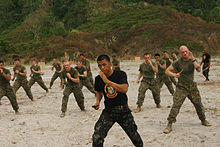
The ranks of enlisted personnel in Filipino are the same as their U.S. counterparts, with some differences. Except in the Marine Corps, never used are the ranks ofspecialist,sergeant first class,andfirst sergeant.Lance corporal,gunnery sergeant,andmaster gunnery sergeantare also never used by the Philippine Marine Corps, whose ranks are the same as the Army's. Additionally,sergeant majorsin the AFP are only appointments for senior rankednon-commissioned officers(NCOs) rather than ranks, examples of such appointments being the Command Sergeant Major, AFP (held by a first chief master sergeant or a first master chief petty officer) and theCommand Master Chief Petty Officer,Philippine Navy (held by an either MCPO or CMS or a SCPO or SMS).
In the Philippine Navy, they also use enlisted ranks which come from the U.S. Navy with their specialization, e.g. "Master Chief and Boatswain's mate Juan Dela Cruz, PN" (Philippine Navy).
In effect, the AFP uses the pre-1955 US military enlisted ranks, with several changes, especially in the Navy and in the senior NCO ranks.
There are no warrant officers in between officer ranks and enlisted ranks.
The uniqueness of Philippine military ranks can be seen in the current highest ranks offirst chief master sergeant(for the Army, Marine Corps and Air Force) andfirst master chief petty officer(for the Navy), both created in 2004, and since then have become the highest enlisted rank of precedence. Prior, first chief sergeant and master chief petty officer were the highest enlisted ranks and rates, the former being the highest rank of precedence for Army, Air Force and Marine NCOs. Today only the rank of first master chief petty officer is unused, but the rank of first chief master sergeant is now being applied.
Five-star rank
[edit]PresidentFerdinand Marcos,who acted also as national defense secretary (from 1965 to 1967 and 1971 to 1972), issued an order conferring thefive-star officerrank to thePresident of the Philippines,making himself as its first rank holder.[citation needed]Since then, the rank of five-star general/admiral became an honorary rank of the commander-in-chief of the armed forces whenever a new president assumes office for a six-year term, thus making the President the most senior military official.[155]
The only career military officer who reached the rank of five-star general/admiralde jurewas PresidentFidel V. Ramos(USMA 1950) (president from 1992 to 1998) who rose from second lieutenant up to commander-in-chief of the armed forces.[156]
General of the ArmyDouglas MacArthurwas also madeField Marshalof thePhilippine Armywith five-star rank in 1938, the only person to hold that rank.Emilio Aguinaldo,the firstPresident of the Philippines,holds an equivalent of five-star general under the titleGeneralissimoandMinister/Field Marshalas the first commander-in-chief of the AFP.
The position is honorary and may be granted to any military officer, especially generals or admirals who had significant contributions and showed heroism, only in times of war and national defense concerns and emergencies. The highest peacetime rank is that of four-star general which is being held only by the AFP Chief of Staff. However, no law specifically establishes the rank of five-star general in the Armed Forces of the Philippines unlike in the United States and other countries.
Rank insignia
[edit]The AFP, like the military forces of Singapore and Indonesia, uses unitary rank insignia for enlisted personnel, in the form of raised chevrons increasing by seniority, same for the Philippine Air Force which uses inverted chevrons from Airman 2nd Class onward only since recently.[157]In the Philippine Navy these are supplemented by rating insignia by specialty, similar to the United States Navy. Like the British and Spanish armed services, however, senior ranked NCOs (especially in the Philippine Navy) also wear shoulder rank insignia only on the mess, semi-dress and dress uniforms, and in some cases even collar insignia. Like the US military all NCOs wear sleeve stripes to denote years of service in the enlisted ranks. Sleeve insignia for enlisted personnel in the Army and the Navy are similar but are different from those used in the US while those in the Marine Corps mirror its US counterpart but with special symbols from Master Sergeants onward (adopted in the early 2000s).
Officer ranks in the AFP are inspired by revolutionary insignia used by the Philippine Army after the 1898 declaration of independence. These are unitary rank insignia used in the every day, combat, duty and technical uniforms both on shoulders and collars (the latter in the khaki uniforms of the Navy), but in the semi-dress, dress and mess uniforms are different: The Army, Air Force and Marine Corps use unitary rank insignia on the shoulder board but the Navy uses the very same rank insignia format as in the US Navy except for the star (for Ensigns to Captains) in almost all officer uniforms and all general officer and flag officer shoulder boards in the full dress uniform are in gold colored backgrounds with the rank insignia and the AFP seal (the star arrangement is the same in the Army, Air Force and Marines but is different in the Navy). The Navy uses sleeve insignia only on its dress blue uniforms. Lieutenants and Captains wear 1 to 3 triangles (and Navy Ensigns and Lieutenants (junior and senior grades) in their working, duty and combat uniforms) while Majors, Lieutenant Colonels and Colonels wear 1, 2, and 3 suns (both triangles and suns have the ancientbaybayinletterka(K) in the center) as well as Navy superior officers (Lieutenant Commanders, Commanders and Captains) in their working, duty and combat uniforms respectively.
Gallery
[edit]- Armed Forces of the Philippines
-
Philippine Navyrigid hull inflatable boats perform a maritime interdiction operation exercise inManila Bay.
-
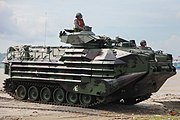 Philippine Marine Corps'KAAV7A1during DAGIT-PA 03-19 exercises
Philippine Marine Corps'KAAV7A1during DAGIT-PA 03-19 exercises -
NAVSOCOMat the SEACAT 2018 Exercise 002
-
Soldiers of the Philippine Army11th "Alakdan" Infantry Division
-
SuluCommanderMajor GeneralWilliam N Gonzales extended his appreciation to the soldiers of the Philippine Army 11th Infantry Division and Joint Task Force
-
Airmen of the710th Special Operations Wingprepare to jump from aKC-130during Parachute Operations training.
-
Philippine Air Force W-3A Sokol in combat helicopter paint scheme before transferring to search and rescue role.
-
Philippine Air ForceS-70i Black Hawk
-
Philippine Air ForceT129B ATAK
-
Two PAF'sFA-50PHfighter jets
-
TheBRPJose Rizal,the first purpose-built vessel of thePhilippine Navy
-
BRPGregorio del Pilarsteam in formation together withBRPEdsa Dosduring the sea phase of CARAT Philippines 2013.
-
TheBRP Antonio Luna (FF-151)Frigate of the Philippine Navy (PN), Photo taken at the Manila South Harbor
-
TheBRPArtemio Ricarteduring the 2008Balikatanexercise
-
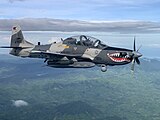 Embraer A-29B Super Tucanoof the Philippine Air Force
Embraer A-29B Super Tucanoof the Philippine Air Force -
Balikatan 2019 - Combined-Arms Live Fire at CERAB
-
ALAV-300vehicle of the Philippine Marine Corps (PMC)
-
Philippine ArmyM113A2 FSV- 2018 Kalayaan Parade
-
Philippine armySabrah light tankon parade
-
APhilippine ArmyM113A2 FSVequipped with a UT30 25mm RCWS
-
Philippine ArmyATMOS-2000
- AFP Flags
-
Flag of the Armed Forces of the Philippines
-
Flag of the Philippine Army
-
Flag of the Philippine Air Force
-
Flag of the Philippine Navy
-
Flag of the Philippine Marine Corps
- AFP Service Patches
-
Battledress identification patch of the Armed Forces of the Philippines
-
Philippine Army battledress patch
-
Philippine Air Force battledress patch
-
Philippine Marine Corps battledress pocket patch
-
Philippine Navy battledress patch
(for NAVSOG Personnel in battledress uniform)
- AFP emblems and patches in the Commonwealth Era
-
Emblem of the Philippine Commonwealth Armed Forces, 1935–1946 (Gold)
-
Shoulder patch of the AFP General Staff, 1946–1965Emblem of the Philippine Commonwealth Armed Forces, 1935–1946
-
Shoulder patch of the AFP General Staff, 1946–1965
See also
[edit]- AFP Modernization Act
- Security sector governance and reform in the Philippines
- Awards and decorations of the Armed Forces of the Philippines
- List of AFP Chiefs of Staff
- List of the AFP Vice Chief of Staff
- List of the AFP Deputy Chief of Staff
- List of the Chief of the Philippine Constabulary
- Women in the Philippine military
- Philippine Constabulary
- Philippine Revolutionary Army
- Military History of the Philippines
- History of the Philippine Army
- List of conflicts in the Philippines
- List of wars involving the Philippines
References
[edit]- ^Romero, Alexis; Tupas, Emmanuel."Marcos appoints Brawner as AFP chief".Philstar.com.
- ^"Philippine military revamping reserve force amid rising regional tensions".November 4, 2023.
- ^"DND Budget GAA 2024"(PDF).www.dbm.gov.ph.
- ^"RAFMP GAA 2024"(PDF).www.dbm.gov.ph.
- ^"UA GAA 2024"(PDF).www.dbm.gov.ph.
- ^"PBBM cited by UN in ASEAN meet on his advocacy on youth, peace, security".PIA.
- ^Central Intelligence Agency."The World Factbook: Military Service Age and Obligation".Archived fromthe originalon June 13, 2007.RetrievedFebruary 28,2016.
17–23 years of age (officers 20–24) for voluntary military service; no conscription; applicants must be single male or female Philippine citizens with either 72 college credit hours (enlisted) or a baccalaureate degree (officers) (2013)
- ^"Internal security gains allow AFP to shift to external defense".
- ^"Cordura named AFP's number two man".Manila Bulletin.November 24, 2022.
- ^"Pilot who led air mobility efforts during Marawi siege takes command of PH Air Force".Manila Bulletin.December 20, 2022.
- ^"Rojas is new PH Marine Corps commandant | Philippine News Agency".Philippine News Agency.
- ^"Speech of President Arroyo during the Commemoration of the Centennial Celebration of the end of the Philippine-American War April 16, 2002".Official Gazette.Government of the Philippines. April 16, 2002.
- ^"Commonwealth Act No. 1".December 21, 1935.
- ^See for exampleManchester, William(1978).American Caesar: Douglas MacArthur 1880–1964.Boston: Little, Brown.ISBN0-440-30424-5.OCLC3844481.
- ^James, D. Clayton (1970).The Years of MacArthur, Volume 1: 1880-1941.Boston:Houghton Mifflin.p. 505.ISBN0-395-10948-5.OCLC60070186.
- ^"Commonwealth Act No. 343 AN ACT TO ABOLISH THE STATE POLICE FORCE, TO REORGANIZE THE PHILIPPINE CONSTABULARY INTO A NATIONAL POLICE FORCE AND PROVIDING FUNDS THEREFOR".June 23, 1938.
- ^"Executive Ordef No. 153 s. 1938 Reorganizing the Philippine Constabulary into a National Police Force".June 23, 1938.
- ^abSchaefer, Chris (2004).Bataan diary: an American family in World War II, 1941-1945.Houston, Tex: Riverview Pub.ISBN0-9761084-0-2.OCLC58386735.
- ^"History".pro7.pnp.gov.ph.
- ^ab"Briefer on Ramon Alcaraz".Official Gazette of the Republic of the Philippines.August 6, 2013.Archivedfrom the original on May 26, 2018.RetrievedMay 26,2018.
- ^Saulo, Alfredo (1990).Communism in the Philippines: An Introduction.Quezon City: Ateneo de Manila University Press.ISBN971-550-403-5.
- ^abcdeParlade, Antonio G. (2015).An Analysis Of The Communist Insurgency In The Philippines.San Francisco: Pickle Partners Publishing.ISBN978-1-78625-282-1.OCLC975223979.
- ^Celoza, Albert F. (1997).Ferdinand Marcos and the Philippines: The Political Economy of Authoritarianism.Greenwood Publishing Group.ISBN9780275941376.
- ^Magno, Alexander R., ed. (1998). "Democracy at the Crossroads".Kasaysayan, The Story of the Filipino People Volume 9:A Nation Reborn.Hong Kong: Asia Publishing Company Limited.
- ^abLee, Terence (January 2, 2015).Defect Or Defend: Military Responses to Popular Protests in Authoritarian Asia.JHU Press.ISBN9781421415161.
- ^abcBerlin, Donald Lane (1982).Prelude to Martial Law: An Examination of Pre-1972 Philippine Civil-military Relations.
- ^abcdefgh"II: Political Change and Military Transmition in the Philippines, 1966 – 1989: From the Barracks to the Corridors of Power".Official Gazette of the Republic of the Philippines.October 3, 1990.RetrievedJuly 30,2021.
- ^"Declaration of Martial Law".Official Gazette of the Republic of the Philippines.Archived fromthe originalon July 8, 2017.RetrievedSeptember 9,2018.
- ^"30 years ago today: Enrile, Ramos withdraw support for Marcos".ABS-CBN News. February 22, 2016.RetrievedAugust 2,2021.
- ^ab"The military's obsession with UP: some historical notes".Vera Files.RetrievedAugust 2,2021.
- ^De Castro, Renato Cruz, Ph.D. The Dilemma Between Democratic. Control versus Military Reforms: The Case of the AFP Modernisation. Program, 1991-2004.https://ciaotest.cc.columbia.edu/olj/jssm/jssm_3_1/jssm_3_1_car01.pdf
- ^"Santa Barbara Project – The Classified Missile Project of the Philippines".kbl.org.ph.
- ^abcDavide, Hilario G. Jr.;Romulo, Ricardo J.; Legaspi, Leonardo Z.; Hernandez, Carolina G.; Lazaro, Delfin L."The Final Report of the Fact-Finding Commission: II: Political Change and Military Transmition in the Philippines, 1966 – 1989: From the Barracks to the Corridors of Power".Official Gazette of the Republic of the Philippines– via Republic of the Philippines National Government Portal (Gov.ph).
- ^abcGAVILAN, JODESZ (September 21, 2020)."Marcos and his men: Who were the key Martial Law figures?".Rappler.RetrievedAugust 5,2021.
- ^"A FILIPINO ON THE SPOT".The New York Times.October 25, 1984.ISSN0362-4331.RetrievedAugust 5,2021.
- ^"PHL marks 29th anniversary of Aquino's assassination on Tuesday".Office of the President of the Philippines. August 20, 2012. Archived fromthe originalon February 8, 2016.
- ^abcRichard, Lim (March 2011)."Civil-Military Relations in Marcos' Philippines"(PDF).CESRAN Papers.2.Centre for Strategic Research and Analysis (CESRAN).
- ^abcde"Backgrounder – Security sector reform, professionalization and the shift to external defense in the Philippines".Centre for Security Governance.Archivedfrom the original on October 26, 2017.RetrievedAugust 2,2021.
- ^abcdefghCruz, Rodel A. (2013)."Security Sector Reform: Way Forward for Democracy and Development"(PDF).National Security Review.December. National Defense College of the Philippines.Archived(PDF)from the original on May 1, 2020.RetrievedSeptember 5,2021.
- ^Oreta, Jennifer Santiago (January 9, 2018)."The Security Reform Agenda for the AFP and PNP in 2018 - Blueboard by".Ateneo de Manila University.Archivedfrom the original on January 11, 2018.RetrievedSeptember 5,2021.
- ^"Alfred McCoy, Dark Legacy: Human rights under the Marcos regime".Ateneo de Manila University.September 20, 1999.
- ^N., Abinales, P. (2005).State and society in the Philippines.Lanham, MD: Rowman & Littlefield Publishers.ISBN978-0742510234.OCLC57452454.
{{cite book}}:CS1 maint: multiple names: authors list (link) - ^"3,257: Fact checking the Marcos killings, 1975-1985 - The Manila Times Online".www.manilatimes.net.April 12, 2016.RetrievedJune 15,2018.
- ^"LOOK BACK: The Philippine Constabulary under Marcos".Rappler.RetrievedJune 18,2018.
- ^W., McCoy, Alfred (2009).Policing America's empire: the United States, the Philippines, and the rise of the surveillance state.Madison, Wis.: University of Wisconsin Press.ISBN9780299234133.OCLC550642875.
{{cite book}}:CS1 maint: multiple names: authors list (link) - ^"Report of an AI Mission to the Republic of the Philippines 1975".Amnesty International.
- ^Robles, Raissa (2016).Marcos Martial Law: Never Again.FILIPINOS FOR A BETTER PHILIPPINES, INC.
- ^"A FILIPINO ON THE SPOT".The New York Times.October 25, 1984.RetrievedJune 18,2018.
- ^Rosenberg, David A. (1974). "Civil Liberties and the Mass Media under Martial Law in the Philippines".Pacific Affairs.47(4): 472–484.doi:10.2307/2755948.JSTOR2755948.
- ^"MANILA NEWSPAPER CLOSED BY MARCOS".The New York Times.RetrievedJune 18,2018.
- ^"The One That Got Away | Newsbreak | Independent Journalism".archives.newsbreak-knowledge.ph.Archived fromthe originalon July 9, 2018.RetrievedJune 18,2018.
- ^"The Haunting of Martial Law: Records from the Marcos Regime".UH School of Law Library.September 7, 2017.RetrievedJune 18,2018.
- ^abc"Philippines: State of Conflict and Violence"(PDF).The Asia Foundation Website.Archived(PDF)from the original on September 8, 2018.
- ^abYegar, Moshe (2002).Between Integration and Secession: The Muslim Communities of the Southern Philippines, Southern Thailand and Western Burma/Myanmar.Lexington Books. pp. 267–268.
- ^Fallon, Joseph E. (August 1989)."Igorot and Moro National Reemergence".Fourth World Journal.2(1). Archived fromthe originalon August 18, 2007.RetrievedSeptember 5,2007.
- ^Marites Dañguilan Vitug; Glenda M. Gloria (March 18, 2013)."Jabidah and Merdeka: The inside story".Rappler.Archived fromthe originalon September 13, 2015.RetrievedSeptember 13,2015.
- ^"Elections of 1986".Malacanang Presidential Museum and Library.Archived fromthe originalon June 21, 2021.RetrievedAugust 4,2021.
- ^"Speech of President Aquino at the anniversary of Tagumpay ng Bayan, February 16, 2012 (English translation)".Official Gazette of the Republic of the Philippines.February 16, 2012.Archivedfrom the original on May 18, 2021.RetrievedMay 18,2021.
- ^abSchock, Kurt (1999)."People Power and Political Opportunities: Social Movement Mobilization and Outcomes in the Philippines and Burma".Social Problems.46(3): 355–375.doi:10.2307/3097105.ISSN0037-7791.JSTOR3097105.
- ^abCruz, Elfren S."The road to EDSA".Philstar.com.RetrievedMay 18,2021.
- ^abResearch, P. D. I. (February 13, 2014)."EDSA Day 1: February 22, 1986".Philippine Daily Inquirer.RetrievedAugust 4,2021.
- ^Lingao, Ed."A 25-year rebellion".Philippine Center for Investigative JournalismWebsite.RetrievedAugust 4,2021.
- ^Carter, April (2013)."People Power Since 1980: Examining Reasons for its Spread, Success and Failure".Sicherheit und Frieden (S+F) / Security and Peace.31(3): 145–150.doi:10.5771/0175-274x-2013-3-145.ISSN0175-274X.JSTOR24233235.
- ^Claudio, Lisandro E. (2013).Taming people's power: the EDSA revolutions and their contradictions.Quezon City:Ateneo de Manila University Press.ISBN978-971-550-655-7.OCLC864093220.
- ^"Corazon Aquino | Biography & Facts | Britannica".www.britannica.com.RetrievedMarch 1,2022.
- ^Fox Butterfield (February 26, 1986)."The Fall Of Marcos - Behind The Presidential Walls - After Marcos Abandons His Palace, Filipinos Shout, 'This Is Ours Now!'".The New York Times.Archived fromthe originalon May 24, 2015.RetrievedAugust 2,2022.
- ^"PURSUANT TO RA NO. 6832: Recommendations of the Final Report of the Fact Finding Commission".Philippine Center for Investigative Journalism.Archived fromthe originalon April 17, 2008.
- ^"R.A. 6832".lawphil.net.RetrievedJuly 30,2021.
- ^"Recommendations of the Final Report of the Fact-Finding Commission".Philippine Center for Investigative Journalism. 2003. Archived fromthe originalon April 17, 2008.RetrievedMay 5,2008.
- ^Francisco, Katerina (September 21, 2016)."LOOK BACK: The Philippine Constabulary under Marcos".Rappler.RetrievedAugust 24,2021.
- ^Hughes, Michelle; Miklaucic, Michael, eds. (October 27, 2016).Impunity: Countering Illicit Power in War and Transition(PDF).Center for Complex Operations and thePeacekeeping and Stability Operations Institute.p. 175.ISBN978-0-9861865-7-8.Archived fromthe original(PDF)on January 16, 2023.RetrievedAugust 26,2024.
- ^"One victory, more needed".The Economist.July 13, 2000. Archived fromthe originalon August 5, 2020.RetrievedAugust 29,2024.
- ^"People Power II: The downfall of a president".CNN.2001.RetrievedAugust 26,2024.
- ^"AFP hopes to recruit 20,000 soldiers in 3 years".ANC News. January 15, 2014. Archived fromthe originalon March 2, 2014.RetrievedFebruary 13,2014.
- ^Medina, Andrei (September 10, 2013)."Timeline: Crisis in Zamboanga City".GMA News Online.Archived fromthe originalon September 29, 2022.RetrievedAugust 26,2024.
- ^Office of Presidential Adviser on the Peace Process (March 7, 2019)."Full implementation of the MILF Normalization Process underway".Office of Presidential Adviser on the Peace Process Website.RetrievedAugust 30,2021.
- ^Office of Presidential Adviser on the Peace Process (June 25, 2019)."Bangsamoro Normalization gains momentum".Office of Presidential Adviser on the Peace Process Website.RetrievedAugust 30,2021.
- ^"Philippine troops seize militant camp".Taipei Times.June 5, 2016. Archived fromthe originalon June 4, 2016.RetrievedAugust 26,2024.
- ^McKirdy, Euan; Berlinger, Joshua (October 17, 2017)."Philippines' Duterte declares liberation of Marawi from ISIS-affiliated militants".CNN.Archived fromthe originalon October 17, 2017.
- ^Nepomuceno, Priam (July 7, 2022)."Duterte admin made significant gains vs. NPA: AFP".Philippine News Agency.Archived fromthe originalon July 7, 2022.
- ^Vitug, Marites(February 16, 2024)."Hindi Ito Marites: Malapit na bang matalo ng AFP ang NPA?".Rappler.Rappler Inc.RetrievedFebruary 20,2024.
- ^AFP Organization,[AFP website].
- ^"Facebook".Facebook.
- ^"PH military adopting new titles: Chief of staff now Joint Chiefs Chair".July 13, 2020.
- ^"MaxDefense received confirmation that AFP has deferred the use of the new designation names, President has not yet approved the use of these".Facebook.July 26, 2020. Archived fromthe originalon February 26, 2022.
- ^"AFP Organization".Archived fromthe originalon April 19, 2008.RetrievedFebruary 3,2008.
- ^"First NOLCOM Commander from PAF assumes".PIA.
- ^Sadongdong, Martin."AFP: Palafox takes helm at Southern Luzon Command".
- ^Beltran, Roger (April 24, 2024)."AFP Visayas Command gets new head".Visayan Daily Star.
- ^Reyes, Victor (April 24, 2024)."New head of military's Visayas Command named".malaya.com.ph.
- ^Dava, Bianca (May 18, 2024)."Carlos out as Wescom chief; Torres assumes post".ABS-CBN.
- ^"AFP installs new EASTMINCOM commander".www.afp.mil.ph.
- ^Francisquete, David Ezra M. (June 10, 2024)."Bergante named new Eastmincom commander".SunStar Publishing Inc.
- ^"New WestMinCom commander vows support to Marcos peace agenda".PeaceGovPH.
- ^Republic Act No. 6975(approved December 13, 1990), Chan Robles Law Library.
- ^Philippine National Police 19th Anniversary(January 28, 2010), Manila Bulletin (archived fromthe originalArchivedJune 14, 2012, at theWayback Machineon June 14, 2012).
- ^ab"The Security Reform Agenda for the AFP and PNP in 2018 - Blueboard by Jennifer Santiago Oreta | Ateneo de Manila University".Archived fromthe originalon September 5, 2021.RetrievedAugust 2,2021.
- ^"Security sector governance and reform in Southeast Asia".BusinessWorld.October 8, 2019.
- ^Security Sector Governance: Applying the principles of good governance to the security sector(PDF).SSR Backgrounder Series. Geneva: Geneva Centre for the Democratic Control of Armed Forces (DCAF). 2015.Archived(PDF)from the original on September 15, 2017.
- ^Security System Reform and Governance.DAC Guidelines and Reference Series. Paris: OECD DAC. 2005.ISBN978-92-64-00786-4.
- ^Price, Megan; van Veen, Erwin (August 19, 2014)."SSR: Securing its success, justifying its relevance".Clingendael.Archivedfrom the original on August 26, 2017.
- ^ab"Security Sector Reform in the Philippines".Middle East Institute.Archivedfrom the original on November 6, 2018.RetrievedSeptember 5,2021.
- ^About the Philippine National policeArchivedMarch 26, 2012, at theWayback Machine
- ^"Legacies".coastguard.gov.ph.RetrievedAugust 30,2021.
- ^CORONEL-FERRER, MIRIAM (2005)."Institutional Response: Civil Society"(PDF).Philippine Human Development Report 2005.Archived(PDF)from the original on September 19, 2011.RetrievedSeptember 6,2021.https://hdn.org.ph/wp-content/uploads/2005_PHDR/2005%20Civil_Society_Assessment.pdf
- ^"Security Reform in the Philippines for 2018".Asia Dialogue.January 29, 2018.RetrievedAugust 29,2021.
- ^abToledo, Mike; Kropholler, Peter (August 24, 2020)."Protect, perform, transform".Annales Henri Lebesgue.Vol. 3. pp. 981–998.doi:10.5802/ahl.51.ISSN2644-9463.RetrievedAugust 29,2021.
- ^Department of National Defense, Republic of the Philippines.TRANSFORMING THE DEPARTMENT OF NATIONAL DEFENSE TO EFFECTIVELY MEET THE DEFENSE AND SECURITY CHALLENGES OF THE 21st CENTURY(PDF)(Technical report).
- ^"Republic Act No. 7898: AFP Modernization Act"(PDF).Government of the Philippines. February 23, 1995.
- ^abOreta, Jennifer Santiago (July 12, 2021)."Security sector reform under PNoy and Duterte administrations".BusinessWorld.RetrievedAugust 5,2021.
- ^"REPUBLIC ACT NO. 10349: AN ACT AMENDING REPUBLIC ACT NO. 7898, ESTABLISHING THE REVISED AFP MODERNIZATION PROGRAM AND FOR OTHER PURPOSES".Government of the Philippines. December 11, 2012.
- ^Comer 2010,pp. 6–7
- ^Comer 2010,p. 7
- ^Comer 2010,p. 8,DND and AFP: Transforming while Performing,Armed forces of the Philippines.(archived fromthe originalArchivedJanuary 28, 2006, at theWayback Machineon January 28, 2006)
- ^Comer 2010,pp. 12–14
- ^Comer 2010,p. 14, citing Philippine Defense Reform Handbook, Revised January 31, 2008.
- ^Comer 2010,p. 16
- ^Comer 2010,p. 21,Executive Order No. 240,Philippine Supreme Court E-Library.(archived fromthe originalArchivedAugust 15, 2011, at theWayback Machineon April 29, 2012)
- ^Comer 2010,p. 18
- ^Comer 2010,p. 27
- ^Comer 2010,p. 34
- ^abComer 2010,p. 35
- ^Comer 2010,p. 36
- ^Promise 62: Implement the Defense Reform ProgramArchivedMarch 17, 2011, at theWayback Machine,ABS-CBN News.
- ^Aquino PromisesArchivedMarch 17, 2011, at theWayback Machine,ABS-CBN News.
- ^"News Archive".U.S. Department of Defense.
- ^"PHL, US inch closer to deal on increased rotational presence of US troops".GMA News Online.March 10, 2014.
- ^Department of Environment and Natural Resources/United Nations Development Programme/Marine Environment and Resources Foundation, Inc. (2004) ArcDev: A Framework for Sustainable Archipelagic Development.
- ^Serafino, N. (2013). Security Assistance Reform: "Section 1206" Background and Issues for Congress. CRS Report for Congress. Accessed from:https://fas.org/sgp/crs/natsec/RS22855.pdf
- ^Voice of America (August 26, 2013). U.S. Significantly Boosts Military Funding for SE Asia. Voice of America. Accessed from:http://www.voanews.com/content/hagel-se-asia-corrected/1737438.html
- ^Acosta, Rene (June 23, 2016)."Gazmin closes Philippine Defense Reform Program | Rene Acosta".RetrievedJune 18,2021.
- ^"Fixed 3-year terms for military chiefs ensure stability of programs".Manila Bulletin.May 19, 2022.
- ^Panti, Llanesca (May 16, 2022)."Duterte signs law granting fixed three-year term for top military officials".GMA News Online.RetrievedMay 7,2023.
- ^"PRRD signs law fixing term of AFP chief, other senior officers".www.pna.gov.ph.
- ^Mangosing, Frances (December 1, 2022)."Lawmakers taking AFP pulse about new law on tenure".INQUIRER.net.
- ^Arevalo (Ret.), Maj Gen Edgard A. (November 27, 2022)."The fates of two AFP chiefs of staff".The Manila Times.
- ^Villanueva, Marichu A."Amend RA 11709".Philstar.com.
- ^Fernandez, Daniza (February 7, 2023)."Grumblings in AFP must end: Senate bill proposes 5 changes to unpopular 3-year rule".INQUIRER.net.
- ^"Alleged rumblings in AFP merely due to RA 11709: Galvez | Philippine News Agency".Philippine News Agency.
- ^"Republic Act No. 11939 | GOVPH".Official Gazette of the Republic of the Philippines.May 17, 2023.
- ^"AFP welcomes General Centino as 59th Chief of Staff, bids farewell to Lieutenant General Bacarro".PIA.January 7, 2023.
- ^Maritime Research Information Center (2013). Overview of the MRIC. Naval Station Francisco. Philippine Navy. Taguig, Philippines. Accessed from:"Press Advisory re Launching of Maritime Research Information Center (MRIC) Inter-Agency Website - Philippine Navy News".Archived fromthe originalon December 18, 2011.RetrievedJune 12,2014.
- ^Executive Order No. 57 by the President of the Philippines. September 6, 2011. Accessed from:"Archived copy"(PDF).Archived fromthe original(PDF)on August 25, 2013.RetrievedJune 12,2014.
{{cite web}}:CS1 maint: archived copy as title (link) - ^"News".Philippine Information Agency.
- ^ab"Gatchalian fights for higher AFP Reserve Force budget".Senate of the Philippines.October 4, 2018.RetrievedNovember 20,2023.
- ^Comer, C. (2010). The Parting of the Sulawesi Sea: U.S. Strategy and Transforming the Terrorist Transit Triangle. United States Army Combined Arms Center. Accessed from:http://usacac.army.mil/cac2/call/docs/11-23/ch_13.asp
- ^"PA shooting team wins Asian Armies Skills at Arms Meet in Australia".balita.ph – Online Filipino News.Archived fromthe originalon July 14, 2014.RetrievedMay 27,2014.
- ^"Philippine Army shooters among the best in the world – The Manila Times Online".The Manila Times.May 18, 2014.
- ^"Pinoy peacekeepers in Golan Heights conferred prestigious UN medal".GMA News Online.April 7, 2014.
- ^Shoulder Ranks (Officers),The Philippine Army.(archived fromthe originalArchivedAugust 1, 2009, at theWayback Machineon July 1, 2012)
- ^"Ranks and insignia".army.mil.ph.Philippine Army. Archived fromthe originalon April 28, 2010.RetrievedNovember 20,2021.
- ^"Ranks".paf.mil.ph.Philippine Air Force. Archived fromthe originalon October 18, 2020.RetrievedMay 27,2021.
- ^"Ferdinand E. Marcos".Archived fromthe originalon August 4, 2008.RetrievedSeptember 30,2013.,Malacañang Museum.
- ^"Fidel V. Ramos".Archived fromthe originalon April 30, 2008.RetrievedApril 30,2008.[failed verification],Malacañang Museum.
- ^Rank insignia of the Philippine armed forces,scribd.com.
Further reading
[edit]- 53rd PC Anniversary Yearbook, 1954 Edition
- Charles 'Ken' Comer,Philippine Defense Reform; Are we there yet?,Asia / South Pacific / India. Russian Military Security Watch,November 2010,U.S. Army Foreign Military Studies Office.










